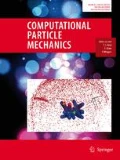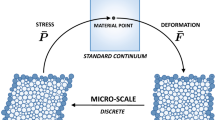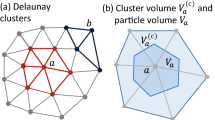Abstract
Numerical simulation of granular systems is often based on a discrete element method. The nonsmooth contact dynamics approach can be used to solve a broad range of granular problems, especially involving rigid bodies. However, difficulties could be encountered and hamper successful completion of some simulations. The slow convergence of the nonsmooth solver may sometimes be attributed to an ill-conditioned system, but the convergence may also fail. The prime aim of the present study was to identify situations that hamper the consistency of the mathematical problem to solve. Some simple granular systems were investigated in detail while reviewing and applying the related theoretical results. A practical alternative is briefly analyzed and tested.
















Similar content being viewed by others
References
Acary V, Brogliato B (2008) Numerical methods for nonsmooth dynamical systems: applications in mechanics and electronics. Springer, Berlin
Acary V, Cadoux F, Lemaréchal C, Malick J (2011) A formulation of the linear discrete Coulomb friction problem via convex optimization. Zeitschrift für angewandte Mathematik und Mechanik 91(2):155–175
Acary V, Cadoux F (2013) Applications of an existence result for the Coulomb friction problem. In: Recent advances in contact mechanics. Springer, Berlin, pp 45–66
Alart P (2014) How to overcome indetermination and interpenetration in granular systems via nonsmooth contact dynamics. An exploratory investigation. Comput Methods Appl Mech Eng 270:37–56
Anderson JD, Wendt J (1995) Computational fluid dynamics, vol 206. Springer, Berlin
Avitzur B, Nakamura Y (1986) Analytical determination of friction resistance as a function of normal load and geometry of surface irregularities. Wear 107(4):367–383
Azéma E, Radjai F, Saussine G (2009) Quasistatic rheology, force transmission and fabric properties of a packing of irregular polyhedral particles. Mech Mater 41(6):729–741
Brogliato B (1999) Nonsmooth mechanics. Springer, Berlin
Cantor D, Estrada N, Azéma E (2015) Split-cell method for grain fragmentation. Comput Geotech 67:150–156
Champneys AR, Varkonyi PL (2016) The Painlevé paradox in contact mechanics. arXiv preprint arXiv:1601.03545
Delassus E (1923) Sur les lois du frottement de glissement. Bulletin de la Société Mathématique de France 51:22–33
Dubois F, Jean M (2006) The non smooth contact dynamic method: recent LMGC90 software developments and application. In: Wriggers P, Nackenhorst U (eds) Analysis and simulation of contact problems. Springer, Berlin, pp 375–378
Frémond M (2002) Non-smooth thermodynamics. Springer, Berlin
Frémond M (2007) Collisions. Dipartemento di Ingeneria Civile, Universitá di Roma Tor Vergata, Rome
Génot F, Brogliato B (1999) New results on Painlevé paradoxes. Eur J Mech A Solids 18(4):653–677
Jean M (1999) The non-smooth contact dynamics method. Comput Methods Appl Mech Eng 177:235–257
Klarbring A, Pang J-S (1998) Existence of solutions to discrete semicoercive frictional contact problems. SIAM J Optim 8(2):414–442
Koziara T, Bićanić N (2011) A distributed memory parallel multibody contact dynamics code. Int J Numer Methods Eng 87(1–5):437–456
Laniel R, Alart P, Pagano S (2008) Discrete element investigations of wire-reinforced geomaterial in a three-dimensional modeling. Comput Mech 42(1):67–76
Lecornu L (1905) Sur la loi de Coulomb. Comptes Rendus Acad Sci Paris 140:847–848
Moreau JJ (1999) Numerical aspects of sweeping process. Comput Methods Appl Mech Eng 177:329–349
Moreau JJ (2003) Modélisation et simulation de matériaux granulaires. In: Actes du 35eme Congres National dAnalyse Numérique
Moreau JJ (2004) An introduction to unilateral dynamics. In: Fremond M, Maceri F (eds) Novel approaches in civil engineering. Lecture notes in applied and computational mechanics, vol 14. Springer, Berlin, pp 1–46
Moreau JJ (2005) Indetermination in the numerical simulation of granular systems. In: Garcia-Rojo R, Herrmann HJ, Mc Namar S (eds) Powders and grains 2005. Balkema, Leiden, pp 109–112
Moreau JJ (2006) Facing the plurality of solutions in non smooth mechanics. In: Nonsmooth/nonconvex mechanics with applications in engineering. Proceeding international conference in memoriam of P.D. Panagiotopoulos. Editions Ziti, Thessaloniki, pp 3–12
Nguyen NS, Brogliato B (2014) Multiple impacts in dissipative granular chains. Lecture notes in applied and computational mechanics, vol 72. Springer
Nguyen D-H, Azéma E, Sornay P, Radjai F (2015) Bonded-cell model for particle fracture. Phys Rev E 91:022203
Orowan E (1943) The calculation of roll pressure in hot and cold flat rolling. Proc Inst Mech Eng 150(1):140–167
Painlevé P (1905) Sur les lois de frottement et de glissement. Comptes Rendus Acad Sci Paris 121:112–115
Perales F, Dubois F, Monerie Y, Piar B, Stainier L (2010) A nonsmooth contact dynamics-based multi-domain solver: code coupling (Xper) and application to fracture. Eur J Comput Mech /Revue Européenne de Mécanique Numérique 19(4):389–417
Radjaï F, Jean M, Moreau JJ, Roux S (1996) Force distributions in dense two dimensional granular systems. Phys Rev Lett 77:274–277
Radjaï F, Wolf DE, Jean M, Moreau JJ (1998) Bimodal character of stress transmission in granular packings. Phys Rev Lett 80(1):61–64
Renouf M, Alart P (2005) Conjugate gradient type algorithms for frictional multi-contact problems: applications to granular materials. Comput Methods Appl Mech Eng 194(18–20):2019–2041
Renouf M, Dubois F, Alart P (2006) Numerical investigations of fault propagation and forced-fold using a non smooth discrete element method. Eur J Comput Mech 15:549–570
Stupkiewicz S, Mróz Z (1999) A model of third body abrasive friction and wear in hot metal forming. Wear 231(1):124–138
Visseq V, Martin A, Iceta D, Azema E, Dureisseix D, Alart P (2012) Dense granular dynamics analysis by a domain decomposition approach. Comput Mech 49:709–723
Author information
Authors and Affiliations
Corresponding author
Rights and permissions
About this article
Cite this article
Alart, P., Renouf, M. On inconsistency in frictional granular systems. Comp. Part. Mech. 5, 161–174 (2018). https://doi.org/10.1007/s40571-017-0160-9
Received:
Revised:
Accepted:
Published:
Issue Date:
DOI: https://doi.org/10.1007/s40571-017-0160-9




